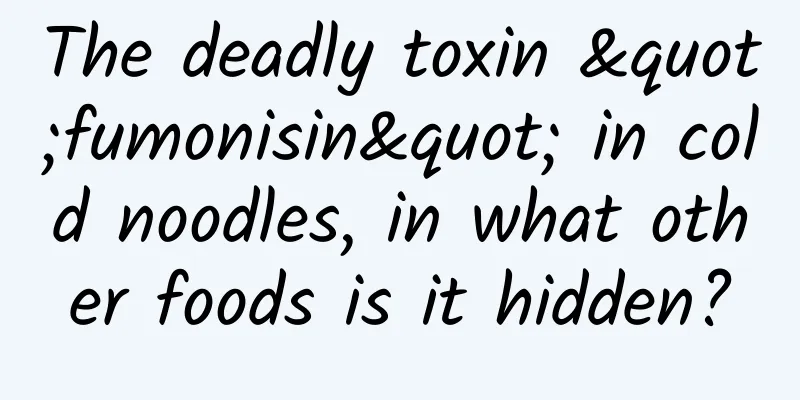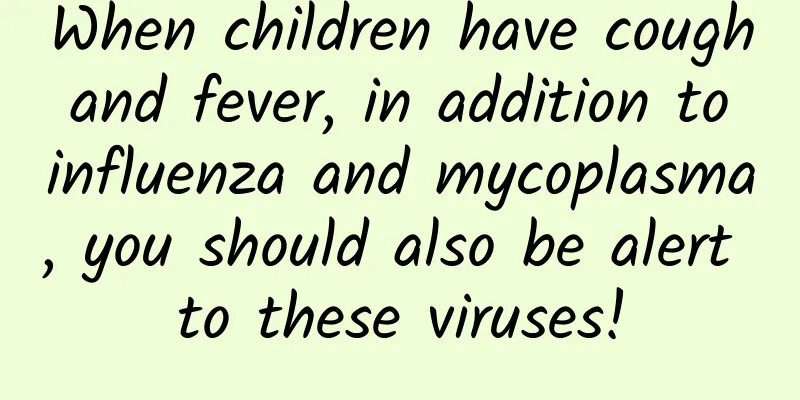The deadly toxin "fumonisin" in cold noodles, in what other foods is it hidden?

|
Recently, the news that one woman died and the other was injured after eating cold noodles became a hot topic on the Internet, sparking related discussions and causing panic among many netizens. The woman's family members said in an interview with the media that after testing, the two people were poisoned by fumonisin. What kind of poison is fumonisin? Can we still eat cold noodles? What exactly is fumonisin? Fusarium oxytocin is a toxin produced by the yeast Pseudomonas cereus subspecies, which is commonly found in foods that have been fermented or soaked for a long time. Pseudomonas cereus is widely distributed in nature and likes to grow on the surface of foods rich in starch. Hot weather will accelerate the growth of fumonisin Food is prone to produce fumonisin in a hot and humid environment. It is extremely heat-resistant and cannot be destroyed even after cooking at 100°C and high pressure. The mortality rate after poisoning is as high as 40% Currently, there is no specific antidote for fumonisin. Once poisoned, it can cause serious damage to important organs such as the liver, kidneys, heart, and brain, with a mortality rate of over 40%. The onset of fumonisin poisoning is rapid, and the incubation period is generally 30 minutes to 12 hours. If you experience diarrhea, abdominal pain, nausea, vomiting, or other discomfort, you must seek medical attention immediately. There are two theories about the cause of the poisoning: one is that too much borax was added to the cold noodles; the other is that the cold noodles were contaminated by bacteria and deteriorated, breeding the fumonisin toxin, which caused the poisoning. These foods can easily cause poisoning In addition to the foods mentioned above, there are 10 common foods that may also produce toxins. Let’s see how we can eat them safely? 1 Wild mushrooms In the wild, non-toxic mushrooms often grow together with poisonous mushrooms. Non-toxic mushrooms are easily contaminated by the mycelium of poisonous mushrooms. Even if you eat non-toxic varieties of mushrooms, there is still a risk of poisoning. 2 Excessive intake of ginkgo Ginkgo nuts contain substances such as hydrocyanic acid and ginkgolic acid. For infants under one year old, 10 nuts can be fatal. 3 Red sugar cane Red sugarcane indicates that it has gone moldy. The 3-nitropropionic acid toxin in it is harmful to the nervous system. Eating it may cause nausea and vomiting at the mildest, and respiratory failure at the worst. 4 Fresh daylily Fresh daylily contains colchicine, which will be oxidized into the highly toxic dicolchicine after entering the human body, which strongly irritates the gastrointestinal tract and respiratory system. 5 Bitter melon seeds and peanuts When peanuts, melon seeds, almonds and other nuts turn yellow or black, or even taste bitter, they may have been contaminated by mold and produced aflatoxin, and should be discarded immediately. Aflatoxin is 68 times more toxic than arsenic and is classified as a Class 1 carcinogen by the World Health Organization's cancer research agency. 6 Rotten ginger Rotten ginger will produce safrole, which can induce esophageal cancer and liver cancer. 7 Uncooked green beans, string beans, and lentils Fresh bean vegetables contain natural toxins such as saponins and hemagglutinins, which are highly irritating to the human digestive tract mucosa and can cause gastrointestinal symptoms. Hemagglutinins exist in beans and have a coagulation effect. If they are not heated thoroughly, eating them can easily cause poisoning, with symptoms such as nausea, vomiting, and numbness of the limbs. 8 Raw soy milk When a lot of white foam appears during cooking, it is a "false boiling" phenomenon, when the temperature inside the soy milk is only 80-90°C. This "half-cooked" soy milk contains plant hemagglutinin, which can cause food poisoning. 9 Sprouted potatoes Sprouted or green potatoes contain a large amount of solanine. Excessive consumption can easily cause poisoning symptoms such as throat itching and burning, gastroenteritis, etc. 10 Sweet potatoes with black spots If black and brown spots appear on sweet potatoes, it means that they may have been contaminated by black spot bacteria, which will produce highly toxic substances such as sweet potato ketone and sweet potato ketone alcohol, which are harmful to the human body. |
>>: Sea otters are stealing surfboards, and now they're being hunted across the ocean
Recommend
Half of the athletes are vegetarian, but they can't eat enough? How hard are the Paris Olympics trying to protect the environment?
The motto of the Olympics is "Higher, Faster...
Snow flower effect
Snow flower is actually a Chinese medicinal herb....
The efficacy and function of Kongqing
Do you know what Kongqing is? If you know, do you...
The efficacy and function of persimmon pedicle [picture]
The medical value of persimmon calyx [picture] is...
In the past 80 years, the alpine shrub line of the willow genus on the Qinghai-Tibet Plateau has climbed 59.3 meters!
Recently, the Ecosystem Pattern and Process Team ...
Floor height ≥ 3, sound insulation +1... This is what the "new house" will look like in the future →
The Ministry of Housing and Urban-Rural Developme...
What are the effects and functions of mixing Panax notoginseng and American ginseng?
The combination of Panax notoginseng and American...
Is freshly slaughtered meat the freshest? The key to choosing a good piece of pork is to look at these 6 points →
Rumor: "Meat that has just been slaughtered ...
The efficacy and function of Psoralea corylifolia
Psoralea corylifolia is also known as Psoralea co...
Huangshan five-leaf ginseng's efficacy and function
There are so many medicinal herbs in the world, a...
Can a crocodile wake up after being frozen into a popsicle? I advise you not to touch the frozen crocodile's nose!
Not long ago, a short video went viral. In the vi...
The efficacy and function of white aconite
Medicine is the best choice for treating diseases...
Fast charging? Flash charging? Only one word difference, but the difference is huge! Don't let your phone die prematurely
In recent years Not only are mobile phones becomi...
Effects of Essence
Women will experience many skin problems as they ...









